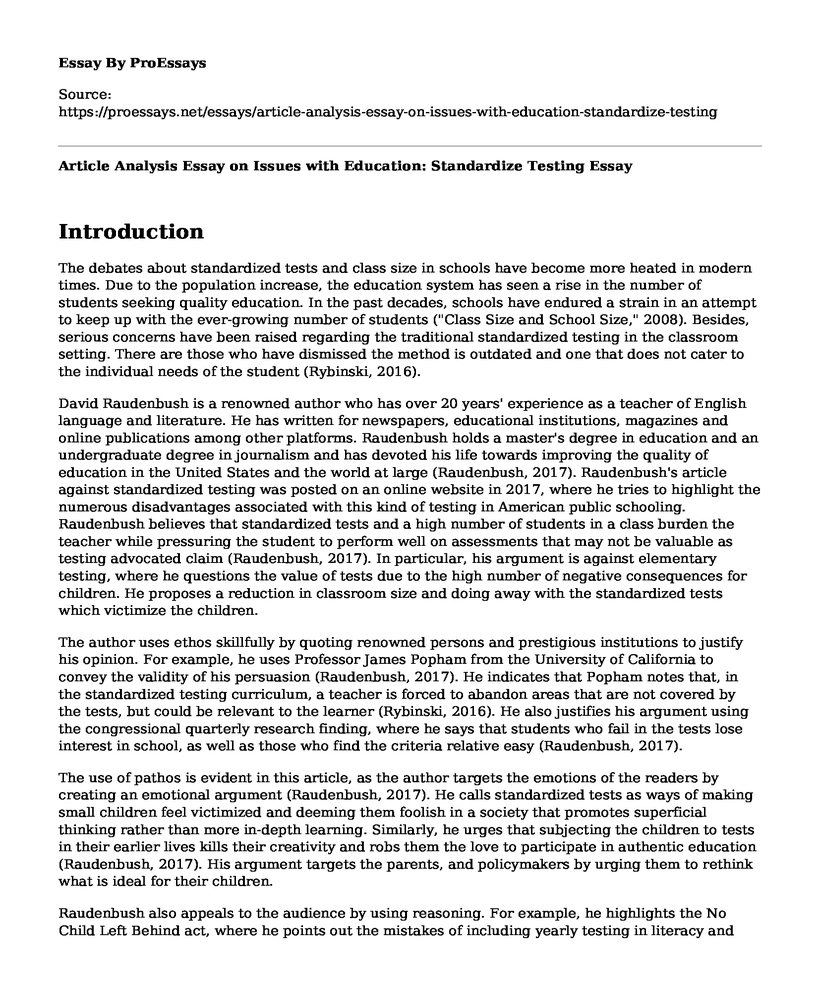Introduction
The debates about standardized tests and class size in schools have become more heated in modern times. Due to the population increase, the education system has seen a rise in the number of students seeking quality education. In the past decades, schools have endured a strain in an attempt to keep up with the ever-growing number of students ("Class Size and School Size," 2008). Besides, serious concerns have been raised regarding the traditional standardized testing in the classroom setting. There are those who have dismissed the method is outdated and one that does not cater to the individual needs of the student (Rybinski, 2016).
David Raudenbush is a renowned author who has over 20 years' experience as a teacher of English language and literature. He has written for newspapers, educational institutions, magazines and online publications among other platforms. Raudenbush holds a master's degree in education and an undergraduate degree in journalism and has devoted his life towards improving the quality of education in the United States and the world at large (Raudenbush, 2017). Raudenbush's article against standardized testing was posted on an online website in 2017, where he tries to highlight the numerous disadvantages associated with this kind of testing in American public schooling. Raudenbush believes that standardized tests and a high number of students in a class burden the teacher while pressuring the student to perform well on assessments that may not be valuable as testing advocated claim (Raudenbush, 2017). In particular, his argument is against elementary testing, where he questions the value of tests due to the high number of negative consequences for children. He proposes a reduction in classroom size and doing away with the standardized tests which victimize the children.
The author uses ethos skillfully by quoting renowned persons and prestigious institutions to justify his opinion. For example, he uses Professor James Popham from the University of California to convey the validity of his persuasion (Raudenbush, 2017). He indicates that Popham notes that, in the standardized testing curriculum, a teacher is forced to abandon areas that are not covered by the tests, but could be relevant to the learner (Rybinski, 2016). He also justifies his argument using the congressional quarterly research finding, where he says that students who fail in the tests lose interest in school, as well as those who find the criteria relative easy (Raudenbush, 2017).
The use of pathos is evident in this article, as the author targets the emotions of the readers by creating an emotional argument (Raudenbush, 2017). He calls standardized tests as ways of making small children feel victimized and deeming them foolish in a society that promotes superficial thinking rather than more in-depth learning. Similarly, he urges that subjecting the children to tests in their earlier lives kills their creativity and robs them the love to participate in authentic education (Raudenbush, 2017). His argument targets the parents, and policymakers by urging them to rethink what is ideal for their children.
Raudenbush also appeals to the audience by using reasoning. For example, he highlights the No Child Left Behind act, where he points out the mistakes of including yearly testing in literacy and math's in grades three to eight (Raudenbush, 2017). He reasons out that this is a mistake as public schools could be used serve the needs of the neediest children in the society could be replaced with profit-oriented schools that operate with less accountability for the education that they provide (Raudenbush, 2017).
Conclusion
In conclusion, the author mostly relies on research and other prominent people's findings to establish his argument. By providing hard evidence, he creates little room for disapproving his reasons as most are based on reputable sources. He also simplifies the discussion and the findings in a manner that an average person can understand. Nonetheless, despite briefly highlighting that classroom size affects the performance of the individual student, he does dwell much on the issue and whether it would still be a factor when the standardized testing method is terminated.
References
Class Size and School Size. (2008). Organizing Schools for Productive Learning, 47-55. doi:10.1007/978-1-4020-8395-2_4
Raudenbush, D. (2017, September 26). Arguing Against Standardized Testing for Elementary Students. Retrieved from https://www.theclassroom.com/arguing-against-standardized-testing-elementary-students-3992.html
Rybinski, K. I. (2016). Does Standardized Testing Make Best High School Students Dumber? SSRN Electronic Journal. doi:10.2139/ssrn.2888796
Cite this page
Article Analysis Essay on Issues with Education: Standardize Testing. (2022, Mar 14). Retrieved from https://proessays.net/essays/article-analysis-essay-on-issues-with-education-standardize-testing
If you are the original author of this essay and no longer wish to have it published on the ProEssays website, please click below to request its removal:
- The Effect of Mobile Learning on the Development of the Students Learning Behaviors and Performance
- Marketing You
- Effects of Reading to Infants and Toddlers on Their Early Language Development
- Article Analysis Essay on Teachers, Social Media, and Free Speech
- Source Evaluation: Alcohol Use in College
- The Short-Term and Long-Term Effects of Divorce on Children Essay
- Essay Sample on Achieve Success: Learn with Great Teacher Leadership







